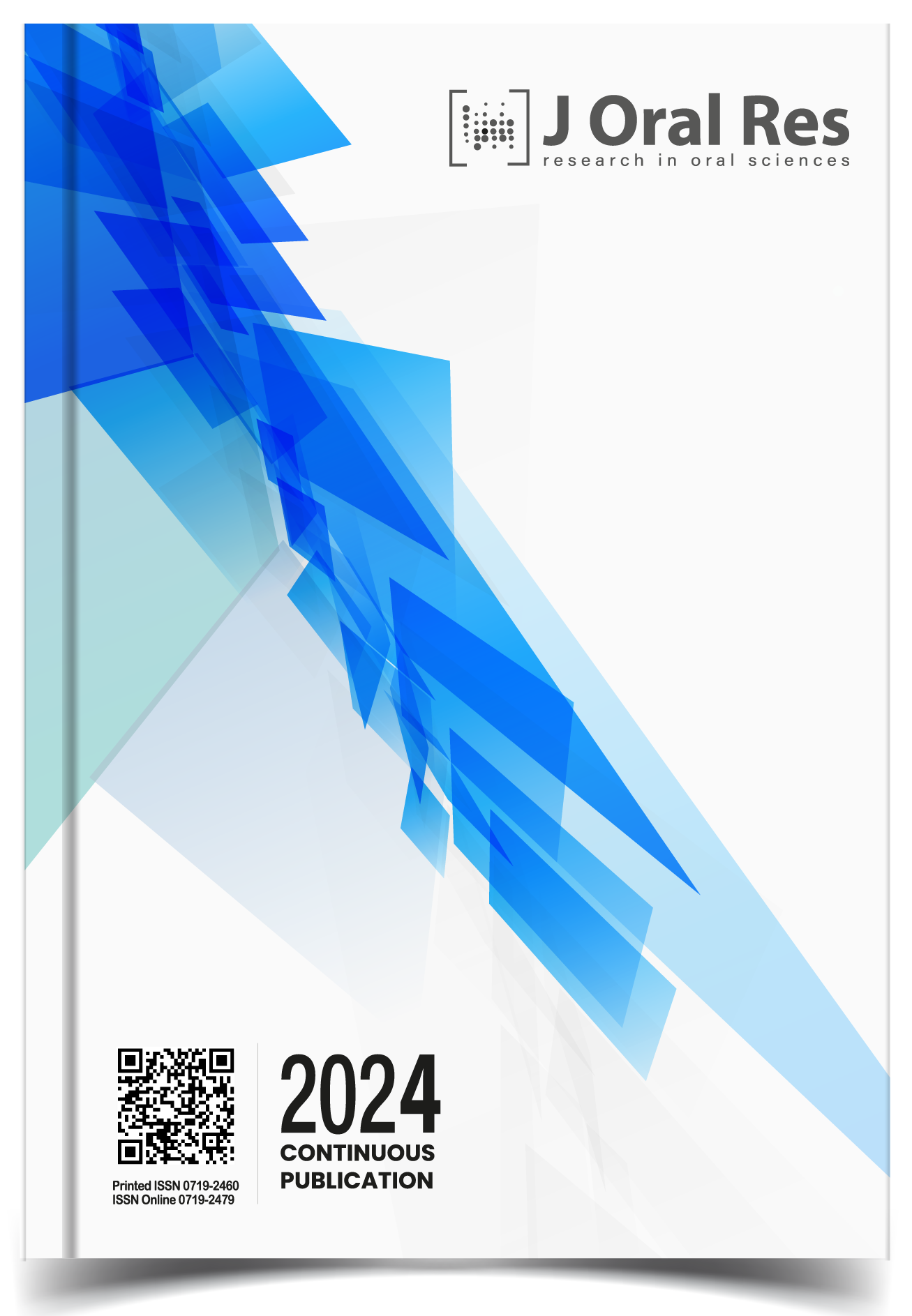Nasolabial anthropometry using 3D computed tomography scan reconstruction: baseline study for nasolabial correction in Indonesian children with cleft lip and palate.
Resumo
Background: The normal nasolabial structure of infants and chil-dren from East Asian, specifically Indonesian, descent groups has been less explored in the literature. This anthropometric study is used as a guide in lip repair in patients with clefts. This retrospective study used archived CT images from the Indonesian population.
Materials and Methods: Computed tomography records of children under 5 years of age were extracted from a provincial hospital. The images were then filtered based on the inclusion and exclusion criteria and then the 2D slices were reconstructed using the open source software Invesalius. Twenty-five variable nasolabial parameters of the nasolabial structure were then measured in the 3D rendering mode. Images with craniofacial dysmorphism or cannulas that passed over the nasolabial structure were excluded. Results were summarized using descriptive statistics.
Results: Fourteen of 128 CT images were included in this study. The samples were divided into two age groups: 0-12 months and 25-54 months. There were moderate to strong, positive correlations between age and all nasolabial variables, which were statistically significant (p<0.05) except for nasal length, nares circumference, columella width, superior philtrum width, philtrum column height, and cutaneous upper lip height.
Conclusions: This study described anthropometric measurements of normal nasolabial structures as a reference point for lip correction surgery. However, to obtain more accurate anthropometric guidelines, further studies with larger sample sizes are desirable. Although surgical repair of the lip is usually performed within the first year of life, some cases of surgery are performed after infancy.
Keywords: Indonesia; Anthropometry; Tomography; Cleft lip; Infant; Child, preschool.
Referências
2. Nasroen SL, Maskoen AM, Soedjana H, Hilmanto D, Gani BA. IRF6 rs2235371 as a risk factor for non-syndromic cleft palate only among the Deutero-Malay race in Indonesia and its effect on the IRF6 mRNA expression level. Dental and Medical Problems. 2022;59(1):59-65.
3. Paradowska-Stolarz, A., Mikulewicz, M. and Duś-Ilnicka, I., 2022. Current concepts and challenges in the treatment of cleft lip and palate patients—A comprehensive review. Journal of Personalized Medicine, 12(12):2089.
4. Kadir A, Mossey PA, Orth M, Blencowe H, Sowmiya M, Lawn JE, Mastroiacovo P, Modell B. Systematic review and meta-analysis of the birth prevalence of orofacial clefts in low-and middle-income countries. Cleft Palate Craniofac J. 2017 Sep;54(5):571-81.
5. Yamanishi T, Kondo T, Kirikoshi S, Otsuki K, Uematsu S, Nishio J. Morphological correlations in nasolabial formation after primary lip repair for unilateral cleft lip. J Oral Maxillofac Surg. 2021;79(10):2126-2133.
6. Ayoub A, Garrahy A, Hood C, White J, Bock M, Siebert JP, Spencer R, Ray A. Validation of a vision-based, three-dimensional facial imaging system. Cleft Palate Craniofac J. 2003;40(5):523–529.
7. Thomas MD, Pfaff MJ, Tonn J, Steinbacher DM. Normal nasolabial anatomy in infants younger than 1 year of age. Plast Reconstr Surg. 2013;131(4):574e-81e.
8. Al-Rudainy D, Ju X, Mehendale FV, Ayoub A. Longitudinal 3D assessment of facial asymmetry in unilateral cleft lip and palate. Cleft Palate Craniofac J. 2019;56(4):495-501.
9. Kurnik NM, Calis M, Sobol DL, Kapadia H, Mercan E, Raymond WT. A Comparative Assessment of Nasal Appearance following Nasoalveolar Molding and Primary Surgical Repair for Treatment of Unilateral Cleft Lip and Palate. Plastic and Reconstructive Surgery. 2021;148(5):1075-1084.
10. Jodeh DS, Ross JM, Leszczynska M, Qamar F, Dawkins RL, Cray JJ, Rottgers SA. Determination of Ethnic Variation in Infant Nasolabial Anthropometry Using 3D Photographs: Implications for Bilateral Cleft Lip Nasal Correction. Cleft Palate Craniofac J. 2021;59(6):693-700.
11. Loo YL, Van Slyke AC, Shanmuganathan P, Reitmaier R, Chong DK. A Guide to Bilateral Cleft Lip Markings: An Anthropometric Study of the Normal Cupid’s Bow. Cleft Palate Craniofac J. 2021; 59(7):926-931
12. Jahanbin A, Emami A, Eslami N. Anthropometric Parameters of Nasomaxillary Complex in 2, 4, 6, and 12-Month-Old Children as a Reference for Cleft Lip and Palate Reconstructive Surgery. J Craniofac Surg. 2021;32(2):597-599.
13. Paradowska-Stolarz A, Kawala B. Dental anomalies in maxillary incisors and canines among patients with total cleft lip and palate. Appl Sci. 2023. 13(11):6635.
14. Paradowska-Stolarz AM, Kawala B. The nasolabial angle among patients with total cleft lip and palate. Adv Clin Exp Med. 2015. 24(3):481-5.
15. Ariawan D, Vitria EE, Sulistyani LD, Anindya CS, Adrin NS, Aini N, Hak MS. Prevalence of Simonart’s band in cleft children at a cleft center in Indonesia: A nine-year retrospective study. Dent Med Probl. 2022. 1(59):509-15.
16. Sarilita E, Rynn C, Mossey PA, Black S, Oscandar F. Nose profile morphology and accuracy study of nose profile estimation method in Scottish subadult and Indonesian adult populations. Int J Legal Med. 2018;132(3):923-31.
17. Sarilita E, Rynn C, Mossey PA, Black S, Oscandar F. Facial average soft tissue depth variation based on skeletal classes in Indonesian adult population: A retrospective lateral cephalometric study. Leg Med. 2020;43:101665.
18. Ayoub A, Khan A, Aldhanhani A, Alnaser H, Naudi K, Ju X, Gillgrass T, Mossey P. The validation of an innovative method for 3D capture and analysis of the nasolabial region in cleft cases. Cleft Palate Craniofac J. 2021;58(1):98-104.
19. Yamada T, Mori Y, Minami K, Mishima K, Tsukamoto Y. Three-dimensional analysis of facial morphology in normal Japanese children as control data for cleft surgery. Cleft Palate Craniofac J. 2002;39(5):517-26.
20. Sarilita E, Setiawan AS, Mossey PA. Orofacial clefts in low‐and middle‐income countries: A scoping review of quality and quantity of research based on literature between 2010‐2019. Orth Craniofac Res. 2021;24(3):421-9.

This work is licensed under a Creative Commons Attribution 4.0 International License.
This is an open-access article distributed under the terms of the Creative Commons Attribution License (CC BY 4.0). The use, distribution or reproduction in other forums is permitted, provided the original author(s) and the copyright owner(s) are credited and that the original publication in this journal is cited, in accordance with accepted academic practice. No use, distribution or reproduction is permitted which does not comply with these terms. © 2024.






